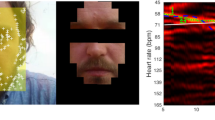Abstract
This paper presents a novel method for fast and quantified estimation of the Perceived Quality of Service (PQoS) for MPEG-4 video content, encoded at constant bit-rates. Taking into account the instant PQoS variation due to the Spatial and Temporal (S–T) activity within a given MPEG-4 encoded content, this paper introduces the Mean PQoS (MPQoS) as a function of the video encoding rate and the picture resolution, and exploits it as a metric for objective video quality assessment. The validity of this metric is assessed by comparing PQoS experimental curves to the theoretical benefit functions vs. allocated resources. Based on the proposed metric, and taking into account the qualitative similarity between theoretical and experimental curves, the paper presents a prototype method for pre-encoding PQoS assessment based on the fast estimation of the S–T activity level of a video signal.
Similar content being viewed by others
References
Alpert T, Contin L (1997) DSCQE experiment for the evaluation of the MPEG-4 VM on error robustness functionality. ISO/IEC—JTC1/SC29/WG11, MPEG 97/M1604
Bradley AP (1999) A wavelet difference predictor. IEEE Trans Image Process 5:717–730
Buxton W (1995) Integrating the periphery and context: a new taxonomy of telematics. In: Proceedings of graphics interface 1995, pp 239–246
Daly S (1992) The visible difference predictor: an algorithm for the assessment of image fidelity. In: Proceedings SPIE, vol 1616. pp 2–15
Guawan IP, Ghanbari M (2003) Reduced-reference picture quality estimation by using local harmonic amplitude information. London Communications Symposium
ISO-IEC 14496 MPEG-4 Coding of Audio Visual Objects
ITU (2000) Methology for the subjective assessment of the quality of television pictures. Recommendation ITU-R BT.500-10
Lai YK, Kuo J (2000) A haar wavelet approach to compressed image quality measurement. Journal of Visual Communication and Image Understanding 11:81–84
Lauterjung J (1998) Picture quality measurement. In: Proceedings of the International Broadcasting Convention (IBC). Amsterdam, pp 413–417
Lee W, Srivastava J (2001) An algebraic QoS-based resource allocation model for competitive multimedia applications. International Journal of Multimedia Tools and Applications, Kluwer, vol 13. pp 197–212
Lu L, Wang Z, Bovik AC, Kouloheris J (2002) Full-reference video quality assessment considering structural distortion and no-reference quality evaluation of MPEG video. IEEE International Conference on Multimedia
Mullin J, Smallwood L, Watson A, Wilson G (2001) New techniques for assessing audio and video quality in real-time interactive communications. In: Third International Workshop on Human Computer Interaction with Mobile Devices. Lille, France
Olson J (1994) In a framework about task-technology fit, what are the tasks features. In: Proceedings of CSCW ’94: Workshop on Video Mediated Communication: Testing, Evaluation & Design Implications
Pereira F, Alpert T (1997) MPEG-4 video subjective test procedures and results. IEEE Trans Circuits Syst Video Technol 7(1):32–51
Richardson IG (2003) H.264 and MPEG-4 video compression: video coding for next generation multimedia. Wiley
Sabata B, Chatterjee S, Sydir J (1998) Dynamic adaptation of video for transmission under resource constraints. In: International Conference of Image Processing. Chicago, October
Seeling P, Reisslein M, Kulapala B (2004) Network performance evaluation using frame size and quality traces of single layer and two layer video: a tutorial. IEEE Communications Surveys 6(3), Third Quarter
Tan KT, Ghanbari M (2000) A multi-metric objective picture quality measurements model for MPEG video. IEEE Trans Circuits Syst Video Technol 10(7):1208–1213
Voran S, Wolf S (2000) Objective estimation of video and speech quality to support network and QoS efforts. In: 2nd Quality of Service Workshop, Houston, Texas, February
VQEG (2000) Final report from the video quality experts group on the validation of objective models of video quality assessment. Retrieved from http://www.vqeg.org
Wang Z, Bovik AC, Lu L (2002) Why is image quality assessment so difficult. Proc IEEE Int Conf Acoust Speech Signal Proc 4:3313–3316
Wang Z, Bovik AC, Sheikh HR, Simoncelli EP (2004) Image quality assessment: from error visibility to structural similarity. IEEE Trans Image Process 13(4):1–14
Wang Z, Lu L, Bovik AC (2004) Video quality assessment based on structural distortion measurement. Signal Process Image Commun 19(2):121–132, special issue on Objective video quality metrics
Wang Z, Sheikh HR, Bovik AC (2003) Objective video quality assessment. In: Furht B, Marqure O (eds) The handbook of video databases: design and applications. CRC, pp 1041–1078
Watson AB, Hu J, McGowan JF (2001) DVQ: a digital video quality metric based on human vision. J Electron Imaging 10(1):20–29
Wolf S, Pinson MH (1999) Spatial–temporal distortion metrics for in-service quality monitoring of any digital video system. In: SPIE International Symposium on Voice, Video, and Data Communications. Boston, pp 11–22
Author information
Authors and Affiliations
Corresponding author
Rights and permissions
About this article
Cite this article
Koumaras, H., Kourtis, A., Martakos, D. et al. Quantified PQoS assessment based on fast estimation of the spatial and temporal activity level. Multimed Tools Appl 34, 355–374 (2007). https://doi.org/10.1007/s11042-007-0111-1
Published:
Issue Date:
DOI: https://doi.org/10.1007/s11042-007-0111-1




